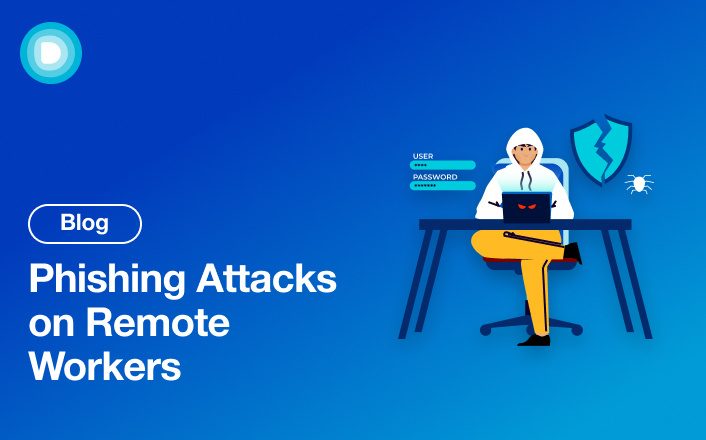- Product
-
Solution
-
By Industry
Cybersecurity solutions tailored to your industry’s needs.
-
- Resources
-
Books
Our ultimate guides and playbooks
Solution Briefs
Overview of PureDome’s functionality
-
Quizzes
Assess your cybersecurity readiness
Case Studies
PureDome customer success stories
Newsletter
Subscribe to the PureDome newsletter
-
- About Us
- Partner
- Pricing
- Download
Phishing Attacks on Remote Workers
-
Aiman Ikram
-
29 May 2024
- 3 min read


As more people work from home, the risk of cybercrime is growing fast. By 2025, it could be worth a whopping $10 trillion! One big problem is phishing attacks, where criminals try to steal your personal information.
But don't worry, we're here to help. We've gathered some easy tips to help you spot these attacks and keep your information safe.
What are Phishing Attacks?
Phishing attacks are like traps set by hackers online. They send fake emails or messages that look real, trying to trick you into giving them your personal info, like passwords or credit card numbers. They might pretend to be from your bank or a company you know. It's important to be careful and not fall for such tricks!
Types of Phishing Attacks
Email Phishing: Fake emails that pretend to be from trusted sources, like banks or companies, aiming to trick you into giving away personal information.
Spear Phishing: Targeted emails sent to specific individuals or organizations, often using personal details to make them seem more convincing.
Clone Phishing: Creating nearly identical copies of legitimate emails, but with harmful links or attachments.
Vishing (Voice Phishing): Scammers make phone calls, pretending to be from legitimate organizations, to obtain personal information over the phone.
Smishing (SMS Phishing): Fake text messages asking for personal information or directing recipients to harmful links.
Whaling: Targeting high-profile individuals, such as CEOs or government officials, to trick them into revealing sensitive information or transferring money.
Phishing Attacks: Key Insights
Phishing is Huge: Every day, a staggering 3.4 billion spam emails are sent, with phishing being the most common cybercrime.
Email Danger: 79% of cyber attacks on UK businesses start with a phishing email, making it a major threat.
Big Costs: A single phishing attack can cost a business up to $47 million, highlighting the serious financial impact.

Best Practices for Remote Workers to Avoid Phishing Attacks
Be Skeptical of Emails and Messages: Always double-check the sender's email address or phone number before clicking on any links or downloading attachments. If the message seems suspicious or asks for personal information, contact the sender directly using a verified method, like calling them or visiting their official website.
Stay Updated and Educated: Keep yourself informed about the latest phishing trends and techniques. Regularly attend cybersecurity training sessions provided by your company or seek out reliable online resources. The more you know about phishing, the better equipped you'll be to recognize and avoid potential threats.
Use Multi-Factor Authentication (MFA): Enable MFA wherever possible, especially for accessing sensitive accounts like your work email or online banking. MFA adds an extra layer of security by requiring more than just a password to log in, making it harder for cybercriminals to access your accounts even if they have your login credentials.
Implement Zero Trust Network Access (ZTNA): ZTNA is a security framework that verifies every user and device attempting to access your organization's network, regardless of their location. By adopting ZTNA, remote workers can securely access company resources without exposing them to potential threats from untrusted networks or devices.

Report Suspicious Activity Immediately: If you receive a phishing email or encounter any suspicious activity, report it to your IT department or cybersecurity team right away. They can investigate the issue and take necessary actions to prevent further attacks. Remember, it's better to be safe than sorry when it comes to cybersecurity.
Future Trends and Insights
Phishing Growth: Cybercrime, including phishing, is expected to rise significantly, with experts predicting a substantial increase in attacks targeting remote workers and exploiting global events, such as economic crises or health emergencies.
Enhanced Security Measures: To counter the growing threat of phishing attacks, organizations are increasingly investing in advanced security technologies and implementing robust cybersecurity protocols. This includes the widespread adoption of multi-factor authentication (MFA), zero-trust network access (ZTNA), and continuous security awareness training for employees.
Targeted Attacks: Phishing attacks are becoming more sophisticated and personalized, with cybercriminals using social engineering techniques to tailor their messages to specific individuals or organizations. This trend highlights the importance of vigilance and ongoing education to recognize and mitigate phishing threats effectively.
How PureDome Helps
PureDome offers vital protection against phishing attacks, utilizing advanced algorithms and real-time threat intelligence to detect and block malicious attempts across multiple communication channels. Its features include email filtering, URL scanning, and malicious link detection, ensuring users can navigate the digital world safely. With continuous updates and cutting-edge technology, PureDome provides peace of mind and robust defense against evolving cyber threats.
Frequently Asked Questions
What should I do if I receive a suspicious email?
Be cautious and avoid clicking on any links or downloading attachments. Report it to your IT department immediately.
How can I protect myself from phishing attacks while working remotely?
Stay informed, use multi-factor authentication (MFA), and implement zero trust network access (ZTNA) for secure access to company resources.
What are some common signs of a phishing email?
Look out for misspelled words, unfamiliar senders, urgent requests for personal information, and suspicious links or attachments.